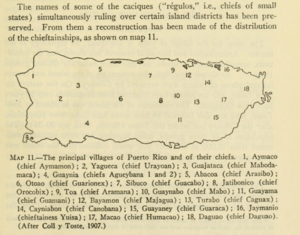Caguax facts for kids
Quick facts for kids Caguax |
|
|---|---|

Smithsonian 1901 map of Puerto Rico caciques
|
|
| Cacique of Turabo | |
| Reign | c. 1508 - c. 1519 |
| Successor | Maria Bagaaname |
| Born | "Borikén" |
| Died | c. 1519 Puerto Rico |
| Issue | Maria Bagaaname Comerio Taya Isabel Taya |
| Mother | Cacica Yayo |
Caguax was an important Taíno chief, also known as a cacique. He lived on the island of Borikén (which was the Taíno name for Puerto Rico) before and during the time the Spanish started to colonize the Americas. His village, called Turabo, was in the Caguas Valley and the mountains around it. This area now includes several modern towns like Caguas, Aguas Buenas, and Gurabo.
Caguax was one of the first Taíno leaders to accept the Catholic faith. He took the Spanish name Francisco but also kept his Taíno name, Guaybanex Caguax. He was a powerful chief and wanted to avoid fighting the Spanish. He knew that if his people fought, they would suffer greatly. So, he looked for peaceful ways to deal with the new situation.
As early as 1508, Caguax worked with the Spanish colonists. He helped them get workers and food. In 1511, after the Taíno Revolt began, he was one of only two chiefs who agreed to make peace with the Spanish. Sadly, Caguax was captured in 1512 and taken to a Spanish farm called Hacienda del Toa. There, he was forced to be the governor's personal servant. Caguax died in captivity around 1518 or early 1519. His daughter, Maria Bagaaname, became the next chief after him.
Contents
Early Encounters with the Spanish
Late in 1508, Juan Ponce de León arrived in Puerto Rico. He was sent by Nicolás de Ovando to start a colony on the island. Ponce de León first met Chief Agüeybaná I in the southwest part of Puerto Rico. They performed a special Taíno ceremony called Guaytiao. In this ceremony, they exchanged names to promise they would not harm each other. This peace agreement allowed Ponce de León to settle on the island. It also helped him get cooperation from Agüeybaná I's allies. These allies helped grow yuca (also known as cassava), which was a root vegetable needed to feed the Spanish settlers.
Caguax and the Spanish Labor System
Caguax was one of the chiefs who agreed to help. He used his authority to organize his nitainos, who were like captains or leaders. These nitainos then directed the naborias, who were the common workers. They grew crops like yuca and peppers for Spanish colonists such as Francisco Robledo and Juan de Castellanos. By 1510, the food grown in Caguax's area was worth 255 gold pesos. Robledo and Castellanos not only had rights to the crops but also to the Taíno people who worked in the fields, called conucos in the Taíno language.
When gold was found in the Turabo River, the Spanish used the same Taíno leadership structure. They forced the Taíno people to work in the mines and rivers to search for gold.
Taíno Revolt and Caguax's Capture
By 1511, the relationship between the Spanish and the Taíno people became very tense. This led to revolts across the island that lasted until 1518. After Ponce de León won the first battles in early 1511, the Spanish offered peace to the Taíno chiefs. Only two chiefs accepted this offer: Caguax and Otoao.
During this difficult time, Ponce de León was replaced as governor by Juan Cerón. Also, Nicolás de Ovando in Santo Domingo was replaced by Diego Colón. Until this point, Caguax, his family, and his people lived in their own village in the Caguas Valley, near the Caguitas River. Archaeologists have found ancient pottery in this area. This shows that people had lived there for a very long time, even before the Taíno period.
Life in Captivity
In early 1512, Governor Cerón took away Ponce de León's chiefs and gave them to his friends. He banished Caguax, his relatives, and his followers to Hacienda del Toa. This was a farm on the northern coast, west of Caparra, which was the first Spanish settlement.
Records show that Caguax's mother, siblings, wives, and children were also taken captive. These records were sent to the Spanish treasury to account for clothes and goods given to the captive Taíno people. Historians believe that Cacica Yayo was Caguax's mother. This meant she was a very important chief, and future chiefs of Turabo would come from her family line.
Caguax's sister, Catalina, should have had the next chief. However, she died in captivity without any living heirs. Her other sister, Maria, also died without heirs. Their brother, Juan Comerio, could not inherit the leadership. Cacica Catalina died soon after being taken to Hacienda del Toa. Caguax died later, between late 1518 and early 1519. Since there was no direct line of succession, María Bagaaname, Caguax's oldest daughter, was given the right to have the next successor. Caguax had two other children named Comerio and Isabel Taya. It's not clear which of his three children were from his two wives, María or Leonor.
Around 1524, Maria Bagaaname married Diego Muriel, who was an overseer at Hacienda del Toa. The Spanish authorities approved this marriage, and they had children. The nitainos who were forced to move with Caguax to oversee the work at Hacienda del Toa included Aguayayex, Guayex, Caguas, Juanico Comerio, Juan Acayaguana, Diego Barrionuevo, Esteban, and Pedro. They directed 230 naborias from Caguax's village. These workers were forced to work in the fields and gold mines. Governor Cerón even made Caguax his personal servant while his people were forced to work.
Legacy
The city and municipality of Caguas, Puerto Rico are named after Chief Caguax. There is also a neighborhood in the city that carries his name.
See also
- List of Puerto Ricans
- List of Tainos
Images for kids


